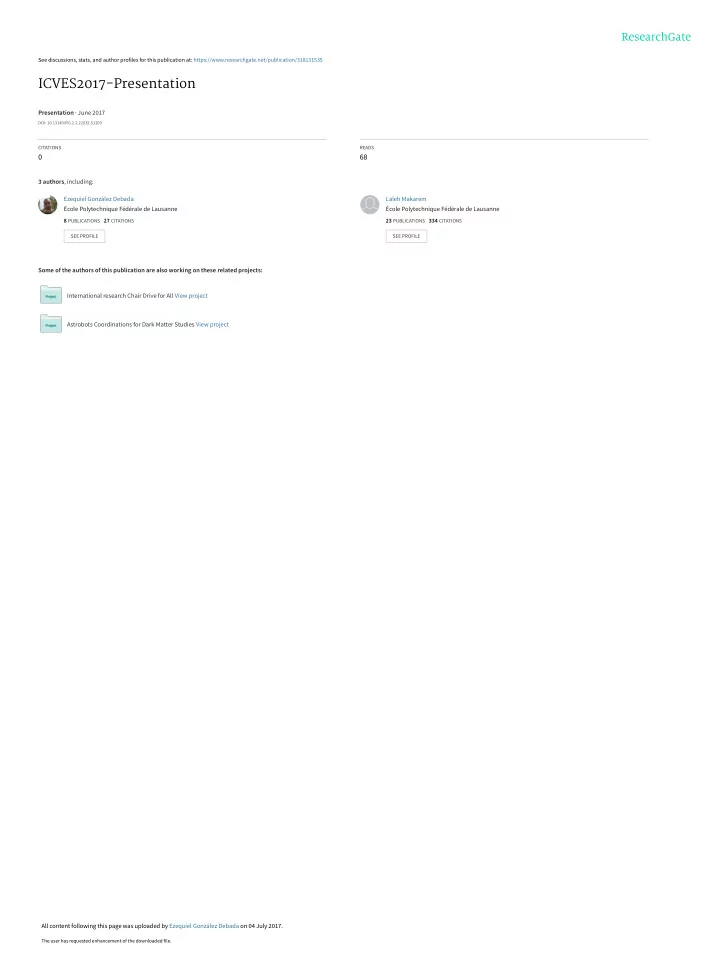

See discussions, stats, and author profiles for this publication at: https://www.researchgate.net/publication/318131535 ICVES2017-Presentation Presentation · June 2017 DOI: 10.13140/RG.2.2.22032.51209 CITATIONS READS 0 68 3 authors , including: Ezequiel González Debada Laleh Makarem École Polytechnique Fédérale de Lausanne École Polytechnique Fédérale de Lausanne 8 PUBLICATIONS 27 CITATIONS 23 PUBLICATIONS 334 CITATIONS SEE PROFILE SEE PROFILE Some of the authors of this publication are also working on these related projects: International research Chair Drive for All View project Astrobots Coordinations for Dark Matter Studies View project All content following this page was uploaded by Ezequiel González Debada on 04 July 2017. The user has requested enhancement of the downloaded file.
A Virtual Vehicle Based Coordination Framework For Autonomous Vehicles in Heterogeneous Scenarios Ezequiel Debada, Laleh Makarem and Denis Gillet ICVES 2017 - Vienna
20 sec motivation ´Likely´ reality Vs Towards better centralization and intersection usage homogeneity ? Heterogeneity Coordination at intersection raising awareness is not only a collision avoidance problem 2
20 sec motivation ´Likely´ reality Vs Towards better centralization and intersection usage homogeneity ? was part of the design process ? What if heterogeneity Heterogeneity Coordination at intersection raising awareness is not only a collision avoidance problem 3
Why another coordination framework? We will Objective present Designing an heterogeneity-friendly framework that Allows Targeted complex scenario interaction Simplifies Interaction the execution of mechanism cooperative maneuvers Maximizes Preliminary the potential control and case study impact 4
Scenario Heterogeneous Connected Distributed Cooperative Cooperativeness uV (unconnected Vehicle) uV cAV ACC ACC (Advanced Cruise Control) cAV (connected AV) 5
Scenario Heterogeneous Connected Distributed Cooperative Cooperativeness uV (unconnected Vehicle) uV cAV ACC ACC (Advanced Cruise Control) cAV (connected AV) ? What to broadcast > How to maximize cooperation impact > 6
Framework building block Virtual Vehicles also referred to as phantom vehicles, projections to model and execute cooperative maneuvers by Inspired lane change indicators Improves cooperative effort increasing maneuver headway interaction among heterogeneous agents requiring only one smart vehicle regulation capabilities of CAVs increasing maneuver options Requires positions and speed 7
Framework building block Virtual Vehicles also referred to as phantom vehicles, projections to model and execute cooperative maneuvers by Inspired lane change indicators Improves cooperative effort increasing maneuver headway interaction among heterogeneous agents requiring only one smart vehicle regulation capabilities of CAVs increasing maneuver options Requires positions and speed 8
Framework building block Virtual Vehicles also referred to as phantom vehicles, projections to model and execute cooperative maneuvers by Inspired lane change indicators Improves cooperative effort increasing maneuver headway interaction among heterogeneous agents requiring only one smart vehicle regulation capabilities of CAVs increasing maneuver options Requires positions and speed 9
Framework building block Virtual Vehicles also referred to as phantom vehicles, projections to model and execute cooperative maneuvers by Inspired lane change indicators Improves cooperative effort increasing maneuver headway interaction among heterogeneous agents requiring only one smart vehicle regulation capabilities of CAVs increasing maneuver options Requires positions and speed 10
Framework building block Virtual Vehicles also referred to as phantom vehicles, projections to model and execute cooperative maneuvers by Inspired lane change indicators Improves cooperative effort increasing maneuver headway interaction among heterogeneous agents requiring only one smart vehicle regulation capabilities of CAVs increasing maneuver options Requires positions and speed 11
Framework building block Virtual Vehicles also referred to as phantom vehicles, projections to model and execute cooperative maneuvers Exogenous , and Endogenous projections (broadcast) (guessed) Every vehicle, no matter its kind, is assigned one projection while maneuvering EGO uV cACC cAVs Nearby car uV en en en cACC en en en uV (unconnected Vehicle) cACC (connected autonomous cruise control) cAV en ex ex cAV (connected autonomous vehicle)
Control architecture Control references Projection (execution) management 13
Control architecture Control references Projection (execution) management Where and when to project? How to control (and coordinate) virtual and real car? 14
Control architecture Control references Projection (execution) management Where and when to project? How to control (and coordinate) virtual and real car? Depends on the maneuver 15
Case study Single lane roundabouts Perfect test-bench for collision avoidance - cooperation - and exploiting knowledge of traffic dynamic 16
Case study Single lane roundabouts Perfect test-bench for collision avoidance - cooperation - and exploiting knowledge of traffic dynamic Projection placement closest gap reachable can be communicated does not disturb* circulating traffic Execution control of projected and real car Projection = car-following model Real car coupling law 17
Models and simulator Longitudinal control Gipps car-following model Merging criteria for uVs and ACC-cars uVs gap-acceptance ACC cooperative effort Dynamics Longitudinal Dynamics, second order model 18
Simulation example The video is available at https://goo.gl/1hV413
Experiments and preliminary results Experiments 6 cases (heterogeneity) and 40 scenarios (traffic level) Cases Case 1 2 3 4 5 6 uV 200 100 100 100 cACCs 200 100 50 cAVs 200 100 50 Results 3000 Throughput 2500 2000 1500 1 3 5 7 9 11 13 15 17 19 21 23 25 27 29 31 33 35 37 39 2200 2000 1800 1600 1400 1 3 5 7 9 11 13 15 17 19 21 23 25 27 29 31 33 35 37 39 Scenario ID 20
Experiments and preliminary results Experiments 6 cases (heterogeneity) and 40 scenarios (traffic level) Cases Case 1 2 3 4 5 6 uV 200 100 100 100 cACCs 200 100 50 cAVs 200 100 50 Results 16 16 Circulating speed Circulating speed 14 14 12 12 10 10 8 8 6 6 4 4 2 2 0 5 10 15 20 0 5 10 15 20 Waiting time Waiting time 21
Wrapping up Friendly integration of Heterogeneity heterogeneous parties requires an extensive evaluation Performance is reflected on the Exploiting traffic dynamic for intersection state smarter CAVs 22
Thank you Any question? View publication stats View publication stats
Recommend
More recommend